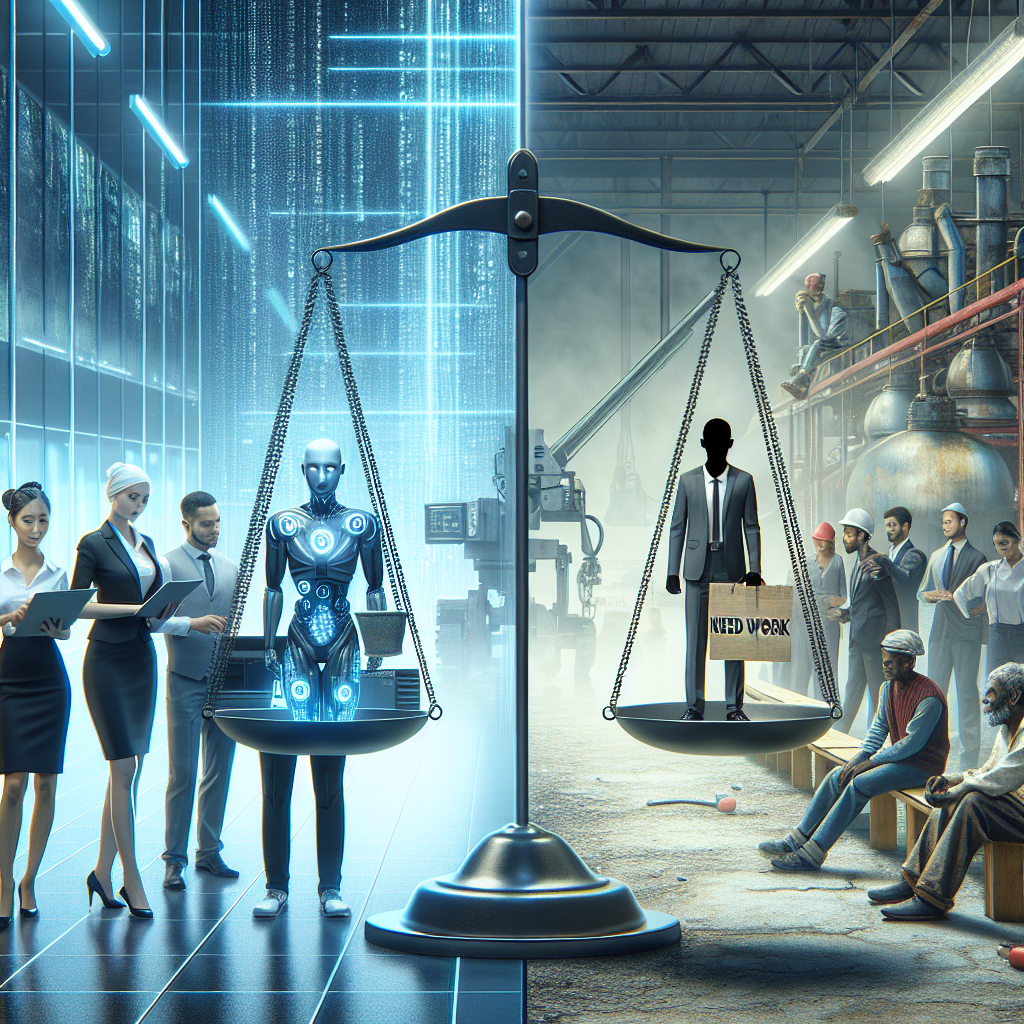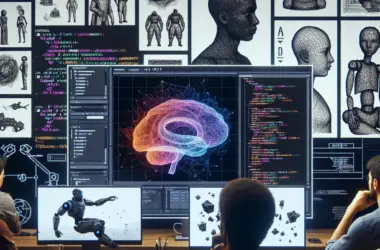Introduction
Artificial Intelligence (AI) is revolutionizing various sectors, including employment, by automating tasks, enhancing productivity, and creating new job opportunities. However, this technological advancement also brings challenges. On the positive side, AI can handle repetitive tasks, allowing employees to focus on more complex and creative work, and can lead to the creation of new industries and job roles. Conversely, AI poses risks such as job displacement, increased inequality, and the need for significant workforce retraining. Understanding the pros and cons of AI in employment is crucial for navigating its impact on the future of work.
The Impact of AI on Job Creation and Job Displacement
The advent of artificial intelligence (AI) has sparked a significant debate regarding its impact on employment, with opinions divided on whether AI will be a boon or a bane for the job market. On one hand, AI has the potential to create new job opportunities and drive economic growth. On the other hand, it also poses the risk of displacing a substantial number of workers, particularly in industries that are highly susceptible to automation. To understand the full scope of AI’s impact on employment, it is essential to examine both the potential benefits and the challenges it presents.
AI’s ability to automate routine and repetitive tasks is one of its most significant advantages. By taking over mundane activities, AI can free up human workers to focus on more complex and creative tasks that require critical thinking and emotional intelligence. For instance, in the manufacturing sector, AI-powered robots can handle assembly line work with greater precision and efficiency than humans, thereby increasing productivity and reducing costs. This shift allows human workers to engage in roles that involve oversight, maintenance, and innovation, ultimately leading to the creation of new job categories that did not previously exist.
Moreover, AI has the potential to drive innovation across various industries, leading to the emergence of entirely new sectors and job opportunities. The development of AI technologies requires a diverse range of skills, including data analysis, machine learning, and software engineering. As a result, there is a growing demand for professionals with expertise in these areas. Additionally, AI can enhance decision-making processes in fields such as healthcare, finance, and logistics, thereby creating new roles that focus on leveraging AI insights to improve outcomes and efficiency.
However, the rapid advancement of AI also raises concerns about job displacement. As AI systems become more capable, they are increasingly able to perform tasks that were once the exclusive domain of human workers. This trend is particularly evident in industries such as retail, transportation, and customer service, where AI-driven automation can handle tasks such as inventory management, driving, and customer interactions. Consequently, workers in these sectors may find themselves at risk of losing their jobs to machines.
The potential for job displacement is further exacerbated by the fact that AI can perform certain tasks more efficiently and at a lower cost than human workers. For example, AI algorithms can analyze vast amounts of data in a fraction of the time it would take a human, leading to faster and more accurate decision-making. While this increased efficiency can benefit businesses, it also means that fewer human workers are needed to perform the same tasks, resulting in job losses.
To mitigate the negative impact of AI on employment, it is crucial for policymakers, businesses, and educational institutions to collaborate on strategies that support workforce transition and upskilling. Investing in education and training programs that equip workers with the skills needed to thrive in an AI-driven economy is essential. Additionally, implementing policies that promote job creation in emerging sectors and provide support for displaced workers can help ensure a more equitable distribution of the benefits of AI.
In conclusion, the impact of AI on job creation and job displacement is multifaceted, with both positive and negative implications. While AI has the potential to drive innovation and create new job opportunities, it also poses significant challenges in terms of job displacement. By proactively addressing these challenges through education, training, and supportive policies, society can harness the benefits of AI while minimizing its adverse effects on the workforce.
How AI is Transforming Workplace Efficiency and Employee Roles

Artificial Intelligence (AI) is revolutionizing workplace efficiency and redefining employee roles in unprecedented ways. As organizations increasingly integrate AI technologies, the landscape of employment is undergoing significant transformations. On one hand, AI offers numerous advantages that enhance productivity and streamline operations. On the other hand, it also presents challenges that necessitate careful consideration and strategic planning.
To begin with, AI significantly boosts workplace efficiency by automating repetitive and mundane tasks. This automation allows employees to focus on more complex and creative aspects of their jobs, thereby increasing overall productivity. For instance, AI-powered tools can handle data entry, scheduling, and customer service inquiries, freeing up human workers to engage in strategic decision-making and problem-solving activities. Consequently, businesses can achieve higher levels of efficiency and accuracy, leading to improved performance and competitiveness.
Moreover, AI facilitates better decision-making by providing valuable insights derived from vast amounts of data. Advanced algorithms can analyze patterns and trends that are beyond human capability, enabling organizations to make informed decisions quickly and accurately. This data-driven approach not only enhances operational efficiency but also helps in identifying new opportunities for growth and innovation. As a result, companies can stay ahead of the curve and adapt to changing market dynamics more effectively.
However, the integration of AI into the workplace also brings about significant changes in employee roles. As certain tasks become automated, there is a growing need for employees to develop new skills and adapt to evolving job requirements. This shift necessitates continuous learning and upskilling to remain relevant in the job market. While some may view this as a challenge, it also presents an opportunity for personal and professional growth. Employees who embrace lifelong learning and acquire new competencies can position themselves as valuable assets in an AI-driven workplace.
Despite these benefits, the rise of AI also raises concerns about job displacement. As machines take over tasks traditionally performed by humans, there is a fear that many jobs will become obsolete. This potential for job loss is a significant drawback that cannot be overlooked. However, it is important to recognize that AI also creates new job opportunities. For example, the development, maintenance, and oversight of AI systems require skilled professionals, leading to the emergence of new roles in the tech industry. Additionally, AI can augment human capabilities, allowing workers to perform their tasks more efficiently and effectively.
Furthermore, the ethical implications of AI in the workplace must be carefully considered. Issues such as data privacy, algorithmic bias, and the transparency of AI decision-making processes are critical concerns that need to be addressed. Organizations must implement robust policies and frameworks to ensure that AI is used responsibly and ethically. This includes fostering a culture of transparency, accountability, and inclusivity to mitigate potential risks and build trust among employees and stakeholders.
In conclusion, AI is transforming workplace efficiency and employee roles in profound ways. While it offers numerous advantages, such as increased productivity and enhanced decision-making, it also presents challenges related to job displacement and ethical considerations. To navigate this complex landscape, organizations and employees must embrace continuous learning, adapt to new roles, and implement responsible AI practices. By doing so, they can harness the full potential of AI while mitigating its drawbacks, ultimately creating a more efficient, innovative, and equitable workplace.
Balancing Automation and Human Skills: The Future of Employment in an AI-Driven World
As artificial intelligence (AI) continues to advance at an unprecedented pace, its impact on the employment landscape has become a topic of significant debate. The integration of AI into various industries promises to revolutionize the way we work, offering both opportunities and challenges. On one hand, AI has the potential to enhance productivity, streamline operations, and create new job categories. On the other hand, it raises concerns about job displacement, skill gaps, and the ethical implications of automation. Balancing automation and human skills is crucial to navigating the future of employment in an AI-driven world.
To begin with, the advantages of AI in the workplace are manifold. AI systems can process vast amounts of data at speeds far beyond human capabilities, leading to more informed decision-making and increased efficiency. For instance, in the healthcare sector, AI algorithms can analyze medical records and imaging data to assist doctors in diagnosing diseases more accurately and swiftly. Similarly, in the financial industry, AI can detect fraudulent transactions and predict market trends, thereby enhancing security and profitability. These applications not only improve service quality but also free up human workers to focus on more complex and creative tasks that require emotional intelligence and critical thinking.
Moreover, AI has the potential to create entirely new job categories that did not exist before. As companies adopt AI technologies, there is a growing demand for professionals who can develop, implement, and maintain these systems. Roles such as AI specialists, data scientists, and machine learning engineers are becoming increasingly vital. Additionally, AI can augment human capabilities, enabling workers to perform their tasks more effectively. For example, customer service representatives can use AI-powered chatbots to handle routine inquiries, allowing them to concentrate on resolving more intricate issues.
However, the rise of AI also brings significant challenges that must be addressed to ensure a balanced and equitable employment landscape. One of the primary concerns is job displacement. As AI systems become more capable, there is a risk that certain jobs, particularly those involving repetitive and routine tasks, may become obsolete. This could lead to widespread unemployment and economic inequality if not managed properly. To mitigate this risk, it is essential to invest in education and training programs that equip workers with the skills needed to thrive in an AI-driven economy. Lifelong learning and reskilling initiatives can help workers transition to new roles and industries, ensuring that they remain relevant and competitive.
Furthermore, the ethical implications of AI in the workplace cannot be overlooked. The deployment of AI systems must be guided by principles of fairness, transparency, and accountability. For instance, AI algorithms used in hiring processes should be designed to eliminate biases and ensure equal opportunities for all candidates. Additionally, there should be clear guidelines on data privacy and security to protect employees’ personal information.
In conclusion, the future of employment in an AI-driven world hinges on our ability to balance automation with human skills. While AI offers numerous benefits, including increased efficiency and the creation of new job categories, it also poses challenges such as job displacement and ethical concerns. By investing in education and training, promoting ethical AI practices, and fostering a culture of continuous learning, we can harness the potential of AI to create a more productive, equitable, and inclusive workforce. As we navigate this transformative era, it is imperative to strike a balance that maximizes the advantages of AI while safeguarding the interests and well-being of human workers.
Q&A
1. **Question:** How can AI positively impact employment?
**Answer:** AI can create new job opportunities by generating demand for AI specialists, data analysts, and cybersecurity experts, and by enabling the development of new industries and services.
2. **Question:** What are some potential negative effects of AI on employment?
**Answer:** AI can lead to job displacement, particularly in roles that involve repetitive tasks, as automation and machine learning systems can perform these tasks more efficiently and cost-effectively than human workers.
3. **Question:** How can workers adapt to the changes brought by AI in the job market?
**Answer:** Workers can adapt by acquiring new skills through continuous education and training, focusing on areas where human expertise is irreplaceable, such as creative problem-solving, emotional intelligence, and advanced technical skills.Artificial Intelligence (AI) has a profound impact on employment, presenting both opportunities and challenges. On the positive side, AI can enhance productivity, create new job categories, and improve workplace safety by taking over hazardous tasks. It can also lead to innovations and efficiencies that drive economic growth. However, the cons include potential job displacement, especially in routine and manual labor sectors, and the need for significant workforce retraining. There is also the risk of increased inequality if the benefits of AI are not widely distributed. Balancing these pros and cons requires thoughtful policy-making, investment in education and training, and a focus on inclusive growth to ensure that the advantages of AI are broadly shared.


